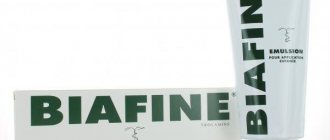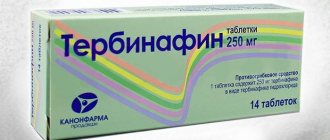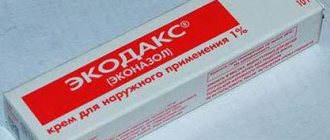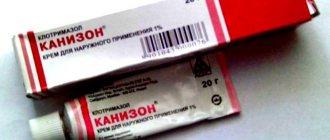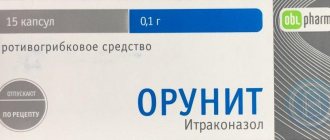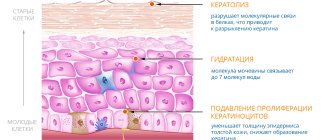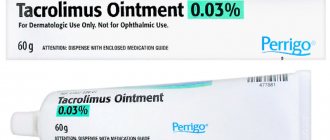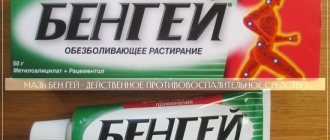Fungal diseases of nails and skin are quite common diseases among the population nowadays. To treat this disease, the pharmacy provides a huge selection of drugs.
Among them, Terbinafine cream is quite popular. The cream is a new generation antifungal agent. Used to treat fungal processes of the skin, nail plates, hair, as well as mucous membranes of various origins.
Compound
Terbinafine tablets contain the active substance terbinafine hydrochloride , as well as additional components: MCC, lactose monohydrate, potato starch, talc, primellose, aerosil, magnesium stearate.
Terbinafine cream contains the active component terbinafine hydrochloride , as well as additional components: benzyl alcohol, stearic acid, distilled glycerol, petrolatum, emulsifier, water, triethanolamine.
The ointment contains the active component terbinafine hydrochloride , as well as additional components: methyl parahydroxybenzoate, carbomer , petroleum jelly, polysorbate, sodium hydroxide, propylene glycol, water.
Terbinafine spray contains the active component terbinafine hydrochloride , as well as additional components: macrogol 400 , water, propylene glycol, ethyl alcohol.
Composition and release forms
Terbinafine has the following dosage forms:
- Pills;
- Cream;
- Ointment;
- Spray.
Terbinafine Cream Terbinafine Ointment Terbinafine Spray Terbinafine
Cream or ointment is available in aluminum tubes of 15 g and 30 g.
The dosage form is in a cardboard box along with instructions.
Manufacturer Vertex, Russia
Ointment and cream are produced in 1% concentration, have a white color, a specific weak medical odor and a uniform consistency. The active substance is terbinafine hydrochloride (Terbinafinum) 1 g when recalculated by 100%.
Excipients in the cream:
- Benzyl alcohol - 1.0 g;
- Distilled glycerin (glycerol) - 18 g;
- Vaseline - 15 g;
- Stearic acid - 5 g;
- Triethanolamine - 0.5 g;
- Emulsifier No. 1 - 8.0;
- Purified water - until 100 grams of cream is obtained.
Excipients in the ointment composition:
- Polysorbate;
- Propylene glycol;
- Methyl parahydroxybenzoate;
- Polyacrylic acid carbomer;
- Sodium hydroxide;
- Vaseline oil;
- Purified water.
Due to its composition, the drug does not affect human hormonal levels.
pharmachologic effect
Terbinafine is a fungicidal, antifungal drug. Demonstrates activity against almost all types of fungi that can infect the human body. In small concentrations it exhibits a fungicidal effect against molds, dermatophytes, and some types of dimorphic fungi. Both fungicidal and fungistatic effects are possible on yeast fungi.
Its therapeutic effect is determined by its destructive effect on the fungal cell membrane, as well as due to the specific inhibition of squalene epoxidase (an enzyme important for the normal function of the fungal cell membrane).
Under the influence of Terbinafine, the production of ergosterol , due to the lack of which the amount of squalene in the fungal cell increases. As a result, all enzyme systems are inactivated, and the cell dies.
The active component does not affect the cytochrome P450 system, therefore, does not affect the metabolism of hormones or other drugs.
Description of the drug
Terbinafine ointment is a broad-spectrum antifungal medication. We are talking about allylamine, which is used to treat the following types of fungi:
- yeast;
- moldy;
- dermatophytes;
- dimorphic.
The pharmaceutical agent exhibits pronounced activity against almost all known pathogens of mycotic etiology. The medicine has a wide variability in the degree of effect. Depending on the type of infection, liniment components can exhibit fungistatic or fungicidal properties.
Clinical and pharmacological group
Ointment (cream) Terbinafine is a non-hormonal, local, antifungal drug. It is used only for local external treatment of skin areas affected by the disease. One of the representatives of the allylamine group of medications. Effectively eliminates pathogenic microflora regardless of its location.
pharmachologic effect
The predominant active component of Terbinafine ointment is terbinafine chloride, which is characterized by pronounced antifungal properties.
Pharmacological action of the substance:
- inhibits biosynthesis reactions (suppresses squalene epoxidase) of sterols at the cellular level;
- forms ergosterol deficiency;
- helps increase the concentration of squalene inside cells.
The activity of the ointment components leads to disruption of the integrity of the membrane structures of the fungus, which invariably ends in their death.
The peculiarity of terbinafine is that it does not affect hormonal metabolism in any way and does not show activity towards other drugs. With regular treatment of the skin, it accumulates in the tissues, guaranteeing pronounced fungicidal activity, which is very important in the treatment of fungus.
Systemic therapy makes it possible to neutralize the risks of relapse with a high probability. In addition to drug treatment, it is necessary to pay attention to the state of the immune system and increase its resistance to pathogenic microorganisms.
Release form and composition
The production of the drug in question is carried out by the Moscow Pharmaceutical Factory (MMF). It is available in several medicinal forms:
- The ointment (cream) has a homogeneous consistency of medium thickness. The drug is packaged in metal tubes of 10-30 g.
- Pills. A plastic blister contains 6 to 10 yellowish tablets. There is a characteristic chamfer on the surface.
- Spray – 1% composition used externally.
The composition of the drug may vary depending on the manufacturer and the form of release. But the main active ingredient is present in each of the listed medications.
The composition of Terbinafine cream (ointment) includes the active component (terbinafine hydrochloride) and a number of minor ingredients:
- medical paraffin;
- Terbinafine
dimethicone; - cetomacrogol 1000;
- distilled water;
- propylene glycol;
- benzyl alcohol;
- poloxamer.
On the territory of the Russian Federation, several pharmaceutical companies are involved in the production of the above-mentioned medications. The compositions of different manufacturers are practically the same.
Storage conditions and periods
According to the annotation, it is recommended to protect Terbinafine ointment (gel) from direct sunlight, storage temperature – up to +25 °C. In sealed packaging, the composition retains its healing properties for 24 months. After the expiration date indicated on the cardboard packaging, the use of the medicine is prohibited, as is the case if the integrity of the metal tube is damaged.
Pharmacokinetics and pharmacodynamics
When taking the medicine orally, the active substance is rapidly absorbed from the digestive tract. Its partial metabolism occurs in the liver, as a result, its bioavailability decreases to 40%. The bioavailability of the drug is only slightly affected by food intake, so there is no need to adjust the dose.
The highest concentration of the drug in the blood is observed 2 hours after the 250 mg tablet was taken. 99% of the active substance in the blood binds to plasma proteins.
The drug is noted to be onycho- and epidermotropic, that is, its largest amount (concentrations optimal for a therapeutic effect) accumulates in the hair, skin, nails, and also in the subcutaneous tissue.
In the body, terbinafine hydrochloride is biotransformed into metabolites that do not demonstrate antifungal activity. Most of them are excreted in the urine. The half-life is 17 hours.
There is no accumulation of Terbinafine when taken. Its effectiveness is the same for all patients, regardless of the person’s age. In the presence of pathological changes in the liver and kidneys, the biotransformation of the drug may slow down. As a result, its concentration in biological fluids increases and the period of circulation of the drug in the blood increases.
When using Terbinafine topically, no more than 5% of the active component enters the blood.
Pharmacological properties
Pharmacodynamics
Terbinafine is an antifungal agent from the allylamine group, which has a wide spectrum of antifungal activity. In low concentrations, the substance has a fungicidal effect on dermatophytes Trichophyton spp. (T. tonsurans, T. rubrum, T. mentagrophytes, T. violaceum, T. verrucosum), Epidermophyton floccosum, Microsporum canis; molds (including Scopulariopsis brevicaulis) and yeasts, mainly Candida albicans, in the form of an ointment - on some dimorphic fungi (Pityrosporum orbiculare). In relation to fungi Candida spp. and their mycelial forms, depending on their type, the drug exhibits fungicidal or fungistatic activity.
Terbinafine leads to disruption of the early stage of biosynthesis of the main structural component of the fungal cell membrane - ergosterol, as well as to the accumulation of squalene in the cell, as a result of which it dies. The action of the active substance is realized by suppressing the enzyme squalene epoxidase located on the wall of the fungal cell.
When used orally, Terbinafine-MFF is not effective in the treatment of lichen versicolor caused by Pityrosporum orbiculare, Pityrosporum ovale (Malassezia furfur).
Pharmacokinetics
When taken orally, terbinafine is well absorbed from the gastrointestinal tract - more than 70%. Due to the first pass effect, absolute bioavailability is reduced by 40%. After a single oral dose of 250 mg, it takes approximately 2 hours to achieve a maximum concentration (Cmax) of 1 µg/ml. It is almost completely bound to plasma proteins - 99%. The area under the concentration-time curve (AUC) is 4.56 μg × h/ml; if the drug is taken with food, it increases by 20%. With long-term use of terbinafine, its Cmax increases by 25% and AUC by 2.5 times. The effective half-life (T1/2) of the drug averages 36 hours, the terminal half-life is 200–400 hours, which indicates its prolonged excretion from adipose tissue and skin.
Age does not affect the equilibrium concentration (Css) of terbinafine, its plasma content does not depend on the gender of the patient. The drug is actively distributed in tissues, passes into the nail plates and the dermal layer of the skin. It is detected in the secretions of the sebaceous glands and accumulates in high concentrations in the skin and subcutaneous tissue, hair follicles, and hair. Terbinafine is metabolized in the liver, in the process inactive metabolites are formed. Eliminated in urine, mostly in the form of metabolites. The drug does not accumulate in the body and is excreted in breast milk.
In patients with liver/kidney diseases, the clearance of terbinafine may be reduced and, as a result, its concentration in the blood may be increased.
When used topically, the absorption of the active substance does not exceed 5%, the systemic effect is insignificant.
Indications for use
The instructions for the use of Terbinafine indicate that all forms of the drug are used for diseases that were caused by yeast-like , molds , and dermatophytes .
The drug in tablets is indicated for use in diseases of fungal origin that were caused by dermatophytes of the genus Trichophyton (T. Mentagrophytes, T. verrucosum, T. Violaceum, T. Rubrum, T. tonsurans), Microsporum canis, Epidermophyton floccosum, as well as fungi of the genus Candida. Tablets are prescribed for trichophytosis , microsporia , onychomycosis , epidermophytosis , candidiasis .
As a rule, Terbinafine tablets are prescribed for widespread and severe symptoms. At the same time, treating lichen versicolor with tablets is ineffective.
What the cream, ointment and spray are for, and whether these local remedies should be used, should be determined by a specialist.
As a rule, the cream should be used for fungal diseases caused by Candida, Microsporum canis, Trichophyton, Pityriasis, Epidermophyton floccosum fungi.
Also, ointment and cream are used for candidiasis, skin lesions caused by dermatophytes, and lichen versicolor.
Contraindications
The use of medication in tablet form is contraindicated for the following diseases and conditions:
- liver disease in chronic or active form;
- chronic renal failure (creatinine clearance less than 50 ml/min);
- the patient’s age is up to three years and his weight is up to 20 kg;
- lactose intolerance, lactase deficiency, glucose-galactose malabsorption;
- lactation;
- high sensitivity to the components of the product.
Caution Terbinafine tablets should be prescribed to people with chronic renal failure (with glomerular filtration more than 50 ml/min based on the Rehberg test), hematopoietic disorders, alcoholism , endocrine diseases, psoriasis , vasoconstriction of the extremities, tumors, systemic and cutaneous lupus erythematosus.
When taking Terbinafine, the condition of the liver and kidneys should be closely monitored. Terbinafine or Terbinafine Teva tablets should be discontinued immediately if the following symptoms occur:
- abdominal pain;
- nausea;
- loss of appetite;
- jaundice;
- weakness;
- darkening of urine;
- light cal.
Forms of the drug for topical use should not be used in case of hypersensitivity or allergies.
Relative contraindications to the use of such drugs are:
- tumors;
- alcoholism;
- liver and kidney failure;
- endocrine diseases;
- narrowing of the lumen of blood vessels;
- hematopoietic disorder;
- The patient's age is up to 12 years.
Indications and contraindications
The main contraindication for which it is really worth refusing to use the drug is hypersensitivity to its components, main or auxiliary.
Restrictions for oral administration (tablets, spray):
- renal and/or liver failure. For this reason, it is necessary to monitor the condition of elderly patients during therapy with Terbinafine;
- lupus erythematosus, psoriasis. An exacerbation of diseases or their relapse is likely when using this drug.
Restrictions for external use (ointment, cream, spray):
- liver and/or kidney failure;
- alcoholism;
- vascular pathologies.
For alcoholism, external use of Terbinafine should be reduced.
During pregnancy, the drug is allowed when the expected benefit far outweighs the possible harm. Make sure that the baby's skin does not come into contact with the surface treated with the drug.
During lactation, use is prohibited, since Terbinafine is excreted in milk.
Side effects include:
- exacerbation of lupus;
- depression, apathy, mental disorders, increased irritability;
- headache, dizziness (often), partial loss of taste;
- tinnitus;
- nausea followed by vomiting, bloating;
- arthralgia;
- increased fatigue, in rare cases – insomnia;
- probably increased body temperature;
- allergic reactions (itching, burning, redness, skin irritation, urticaria, swelling).
In rare cases, side effects from the circulatory system, for example, anemia, are possible.
Side effects
When taking pills, patients may experience the following side effects:
- feeling of pain and weakness in the epigastric region;
- loss of appetite;
- cholestasis;
- taste disturbance;
- allergic reactions;
- nausea;
- diarrhea;
- decreased levels of platelets and neutrophils in the blood.
When applied topically, itching, burning and hyperemia may occur in the areas where the product was applied. Allergic manifestations may develop in rare cases.
Side effects
Side effects may occur when treated with Terbinafine cream.
Reactions with external manifestations are more common, namely:
- Itching and irritation around the nail plate - this is due to the high sensitivity of the skin to the drug;
- An allergic reaction to the drug in the form of a rash or hives;
- Peeling of the skin or even the appearance of microcracks;
- Feeling of pain and burning.
It should be noted that the occurrence of adverse reactions is individual in nature and may not occur in all patients. More often, the drug in the form of a cream is easily tolerated.
Instructions for use of Terbinafine (Method and dosage)
Terbinafine tablets, instructions for use
The duration of taking the tablets should be determined by the doctor, taking into account the severity of the disease. Children should take the product after meals, this should be done once a day. When determining a single dose of medication, it is necessary to take into account the child’s body weight.
Children weighing less than 20 kg receive 62.5 mg of the drug, children weighing from 20 to 40 kg - 125 mg, children weighing over 40 kg - 250 mg.
Adult patients receive 250 mg Terbinafine Teva or Terbinafine tablets once daily or 125 mg twice daily.
The duration of treatment depends on the disease. For tinea pedis, you need to take the tablets for 2 to 6 weeks.
For candidiasis of the skin, dermatomycosis of the extremities, trunk, legs, treatment lasts from 2 to 4 weeks.
For infections of the scalp, treatment lasts 4 weeks.
For onychomycosis, effective treatment of the disease is possible if the drug is taken for 6 to 12 weeks. Sometimes, if the patient has a reduced rate of nail growth, treatment may take longer. The effect will be observed several months after completion of the course of treatment.
Terbinafine ointment, instructions for use
Ointment or cream is applied to the affected areas 1-2 times a day. Before applying the product, you need to very thoroughly clean and dry the affected skin. Apply a thin layer of the product to the affected areas and surrounding areas and rub in lightly. If during the development of the infection the patient experiences diaper rash, these areas can be covered with gauze after applying the product. It is advisable to do this if the ointment or cream is applied at night.
The duration of treatment depends on the disease. For candidiasis of the skin, dermatomycosis of the extremities, torso, and legs, the product should be applied for 1-2 weeks.
When treating lichen versicolor – 2 weeks.
Treatment of tinea pedis lasts 2-4 weeks.
For mycosis of the nail plates, the product is applied for 3-6 months.
As a rule, clinical manifestations decrease after the first days of using the medicine. It should be borne in mind that if the product is not applied regularly or therapy is stopped prematurely, the infection may recur. Provided that after two weeks of regular use of Terbinafine the manifestations of the disease do not decrease, you should consult a doctor and clarify the diagnosis.
The spray is used externally, it should be used 1-2 times a day.
What does Terbinafine cream help with?
Used for fungal infections with lesions of the skin and nail plates, mucous membranes:
- Dermatomycosis of the skin and feet;
- Candidiasis , including diaper rash caused by fungus;
- Onychomycosis - affects the nails;
- Microsporiasis - affects the scalp and body;
- Trichophytosis - damage to the skin, hair and nails;
- Versicolor or pityriasis versicolor.
The cream is used not only for the treatment of fungal diseases, but also for the purpose of prevention. It is especially useful to treat the surface of the feet after visiting public places, namely saunas, baths and swimming pools.
Overdose
If an overdose of Terbinafine in tablet form occurs, the patient may experience a rash , nausea , headache , vomiting , dizziness , epigastric pain, and frequent urination. It is important to perform gastric lavage; they also practice taking activated carbon and symptomatic treatment.
There is no data on an overdose of the drug in the form of external agents. If accidentally ingested as an ointment or cream, nausea, headache, dizziness, and epigastric pain may occur. In this case, symptomatic treatment is carried out; the use of activated carbon is indicated.
Use during pregnancy and lactation
During pregnancy, the drug can be used if the required benefit from treatment is greater than the harm caused.
When breastfeeding, the appearance of concentrations in breast milk should be taken into account.
Therefore, it is advisable to transfer the baby to artificial feeding during the treatment period.
Such measures can be explained by the fact that the effect of the antifungal agent on the baby’s body has not been fully studied.
It is also necessary to strictly avoid contact of Terbinafine cream with the baby’s skin. It is also contraindicated to treat nipples with an antifungal agent when breastfeeding to avoid the medicine getting into the baby's stomach.
Treatment with an antifungal agent during pregnancy and lactation is no different from the above rules for antifungal treatment.
Interaction
When using Terbinafine, there may be an effect on the clearance of drugs whose metabolism involves the cytochrome P450 . These are Tolbutamide , Cyclosporine , oral contraceptives .
Increases the concentration of H2-histamine blockers in the blood plasma.
Slows down the excretion of Rifampicin , in turn, Rifampicin doubles its clearance.
Women who use oral contraceptives may experience menstrual irregularities.
Terfenadine inhibits the CYP2P6 isoenzyme, which leads to an obstruction of the metabolism of tricyclic antidepressants, beta-blockers, selective serotonin reuptake inhibitors, antiarrhythmic drugs, type B monoamine oxidase inhibitors, and antipsychotic drugs.
Under the influence of Terbinafine, the clearance of caffeine decreases by 21%, while its half-life increases by 31%.
Has no effect on the clearance of Digoxin , Phenazone , Warfarin .
When taken simultaneously with ethanol or with drugs that have a hepatotoxic effect, the likelihood of drug-induced liver damage increases.
Drug interactions
Based on research results, it has been proven that parallel use of Terbinafine with other drugs rarely inhibits their pharmacological properties. Minimal influence is present regarding medications that are metabolized in the body under the influence of the cytochrome P450 system, such as Terfanadine, Tolbutamide, Triazolam and oral contraceptives; in other cases, the interaction of drugs does not affect their effect on the body. Women taking contraceptives and simultaneously taking Terbinafine tablets may experience disruptions in the menstrual cycle.
Some drugs that cause the induction of cytochrome P450 enzymes enhance the effect of Terbinfin, for example, Rifampin, and some, on the contrary, slow it down (Cimetidine). If it is necessary to take these drugs in parallel, the doctor will most likely adjust the single dose. Ethanol and other hepatotoxic drugs increase the risk of developing hepatotoxicity.
Terbinafine reduces the effectiveness of Desipramine by 82% and weakens the effectiveness of Cyclosporine by 20%. However, it does not affect the work of Cotrimoxazole, Zidovudine and Theophylline. Sometimes changes in INR and prothrombin time may occur when taking Terbinafine and Warfarin together.
special instructions
When treating onychomycosis for six weeks, it is not necessary to remove the affected nail plates.
It is important to consider that if the medication is not used regularly and its use is stopped prematurely, a relapse of the disease may occur.
The duration of treatment with Terbinafine may be affected by the presence of other diseases in the patient.
Systemic use of the drug in patients with onychomycosis is advisable only in cases of total damage to most nails, in the presence of subungual hyperkeratosis , and also in the absence of effect after local treatment.
People with liver disease may have reduced clearance of terbinafine.
During treatment, liver transaminase activity in the blood should be monitored.
Hepatitis and cholestasis may occur three months after starting treatment, but this occurs only in rare cases. If the patient develops signs indicating liver dysfunction, the medication is discontinued.
The drug should be prescribed with caution to patients suffering from psoriasis , as the medicine can provoke an exacerbation of this disease.
It is necessary to carefully observe all the rules of personal hygiene during the treatment process to prevent re-infection. After completion of treatment and during its process (two weeks after the start), you need to practice antifungal treatment of socks, stockings, and shoes.
Irritation can be caused by Terbinafine cream or ointment, which is why you should not allow these products to come into contact with your eyes. If the product gets into your eyes, rinse them immediately with clean water. If symptoms of irritation persist, you should consult your doctor.
In case of allergic manifestations, the medicine is discontinued.
Analogs
Level 4 ATX code matches:
Atifin
Binafin
Lamican
Griseofulvin
Analogues in tablets are the drugs Lamican , Onychon , Terbizil , Binafin , Exifin , Myconorm , Terbinafine hydrochloride , etc.
Analogues of Terbinafine for external use are the drugs Termicon , Lamisil Uno , Terbinox , Terbizil , Mikonorm , Lamitel , Terbinafine-MFF , etc.
Reviews of Terbinafine
Both reviews of Terbinafine tablets and reviews of cream and ointment appear online in most cases, positive. Patients write about the quick effect after starting to take Terbinafine and Terbinafine Teva tablets. With their help, it was possible to get rid of fungal diseases and restore the structure of the nails.
Those who have used Terbinafine ointment also leave positive reviews, noting that the product is inexpensive, but at the same time it allows you to completely cure fungal diseases and get rid of diaper rash in a few weeks. However, side effects develop very rarely.
Reviews
Victor, 43 years old, St. Petersburg
On the recommendation of a dermatologist, I treated lichen versicolor with Terbinafine MFF ointment. As a result, there was no result: the problem did not disappear, and the affected area even increased. I decided to treat myself with Lamisil ointment, but it didn’t help either. After 1.5 months, I signed up for an examination at a paid clinic, where I was already prescribed Orungal, in the form of tablets. They really coped with the lichen, but the liver was damaged decently. The obvious conclusion is: don’t self-medicate, it will cost you more!
Maria, 34 years old, Bryansk
Hello! Please help me with my problems! On the feet, 4 nail plates are affected by fungi at the initial-middle stage. She was treated with Bifosin, but the drug was not enough for the full course, so she was treated with Terbinafine. What are the consequences of such a replacement? How critical is the consumption of alcoholic beverages and the simultaneous use of ointment?
Alexandra, 29 years old, Vladivostok
As a souvenir of my summer vacation, I was left not only with excellent photographs, but also with foot fungus. After an examination, the dermatologist prescribed only Terbinafine ointment. It helps get rid of redness and irritation of the skin. After 2 weeks of treatment, no fungal spores were found in the scrapings.
Maria, 47 years old, Astrakhan
Judging by the reviews, Terbinafine ointment for nail fungus is used for six months. I have been using it for 3 months, but it is already clearly noticeable that a healthy plate has begun to grow. The doctor is advised not to take breaks in treatment, otherwise recovery will slow down.
Read further:
Lamisil: what it helps with, instructions for using cream and ointment, analogues and reviews
Pimafucin cream for men: review and reviews
Boromenthol ointment: instructions for use, review and reviews
Betamethasone ointment: instructions for use, review and reviews
Sulfur ointment for nail fungus: patient reviews, instructions for use and review of analogues
Terbinafine cream (review) from 120 rub.
Overall
4.7
- Efficiency
- Price
- Safety
- Availability
Pros
- Efficiency
- Price
- Well absorbed
- Smell
Cons
- Contraindications
Terbinafine price, where to buy
The price of Terbinafine in tablets is from 210 rubles for 10 pieces. Terbinafine Teva tablets can be bought for an average of 130 rubles. (pack of 7 pcs.). The average price of Terbinafine cream is 80 rubles. per pack 15 g. The price of Terbinafine spray is from 300 rubles. for 30 ml.
Price of Terbinafine ointment in UAH. (Ukraine) – from 100 UAH. You can purchase the product in Dnepropetrovsk and other cities by order.
- Online pharmacies in RussiaRussia
- Online pharmacies in UkraineUkraine
ZdravCity
- Terbinafine Canon tablets 250 mg 10 pcs. JSC Canonpharma Production
RUB 135 order - Terbinafine tablets 250 mg 14 pcs. JSC Medisorb
RUB 224 order
- Terbinafine-mff tablets 250 mg 10 pcs. JSC Moscow Pharmaceutical Factory
128 rub. order
- Terbinafine tablets 250 mg 10 pcs. JSC Biocom
RUB 183 order
- Terbinafine-mff ointment d/nar. approx. 1% tube 15g ZAO Moscow Pharmaceutical Factory
83 RUR order
Pharmacy Dialogue
- Terbinafine-Canon tablets 250 mg No. 14Canonpharma Production
RUB 245 order
- Terbinafine-MFF (250 mg tablet No. 10) MFF
78 RUR order
- Terbinafine 1% spray 20gVIPS-Med
RUB 165 order
- Terbinafine (cream 30g)Vertex
250 rub. order
- Terbinafine tablets 250 mg No. 10Vertex
320 rub. order
show more
Pharmacy24
- Terbinafine-KV 250 mg No. 14 tablets PAT "Kiev Vitamin Plant", Kiev, Ukraine
80 UAH. order
Price and analogues
Binafin contains the same active substance
You can purchase Terbinafine at any pharmacy or online store. Some pharmacies sell tablets only with a doctor's prescription, but they can often be purchased without a prescription. Products for external use (ointment, spray and solution) are freely available. The pricing policy for a medicinal product of the same form can differ significantly, and this depends not only on the markup at the pharmacy, but also on a number of other factors.
Price for Terbinafine drugs:
- Cream 1% 15 g – 69 rubles, ointment 1% 15 g – 82 rubles, cream 1% 30 g – 123 rubles,
- spray 1% 20 g – 172 rubles per package,
- tablets 250 mg 14 pcs. – 175 rubles, 250 mg tablets 10 pcs. (Vertex) – 193 rubles, 250 mg tablets 30 pcs. (Vertex) – 407 rubles.
You can purchase analogues of Terbinafine with the same composition and effect on the body. Most often, doctors recommend:
- Atifen cream, 1%, 15 g in a tube – 193 rubles;
- Binafin cream, 1%, 10 g in a tube – 330 rubles;
- Binafin tablets, 250 mg 14 pieces – 609 rubles;
- Lamisil cream, 1%, 15 g in a tube – 538 rubles;
- Lamisil spray, 1%, 15 ml – 566 rubles;
- Lamisil tablets, 250 mg 14 pieces – 2284 rubles;
- Terbizil cream, 1% (Hungary), 15 g in a tube – 301 rubles;
- Terbizil tablets, 250 mg, 14 pieces – 759 rubles, 27 pieces – 1569 rubles.
Prices in different cities and pharmacies may differ depending on the prices of delivery of goods and the retailer's markup.
